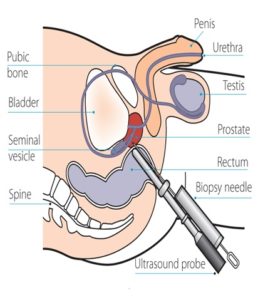
Diagnosed with Cancer? Your two greatest challenges are understanding cancer and understanding possible side effects from chemo and radiation. Knowledge is Power!
Learn about conventional, complementary, and integrative therapies.
Dealing with treatment side effects? Learn about evidence-based therapies to alleviate your symptoms.
Click the orange button to the right to learn more.
- You are here:
- Home »
- Blog »
- side effects ID and prevention »
- Prostate Cancer Biopsy- “…piss blood for a week, and shit blood for a day.”
Prostate Cancer Biopsy- “…piss blood for a week, and shit blood for a day.”

The results of my PCa biopsy will be discussed at our next scheduled appointment, a month later. I go home to piss blood for a week, and shit blood for a day.
So with that procedure done (cystoscopy), we move right into the biopsy, which has not been prefaced with much explanation as to what will happen. They remove the stirrups and tell me to lie down on my side, legs up toward my chest, for access. They squirt lubricant into my ass, a considerable amount to the point that it is leaking down my ass cheeks.
The ultrasound driven probe is inserted fairly deep and there is a prick of pain when the tip of the probe breaks through the anus wall to get to the prostate. Not too bad.
The doctor proceeds to tell me they will be taking six samples, and that there will be a loud noise followed by a slight prick. This explanation is far from being truthful. The noise sounds like staple gun and the little prick is a sense of pain through the whole body. It feels like a cattle prod electrocuting me deep inside my ass.
Again i am admonished for my whimpish response to these clips being take out of my prostate. I am lying there, counting the samples, thinking I only have to endure this shock treatment six times. It is then that I am informed that the six samples were only from one side of my prostate, that the there will be another six samples taken from the other side.
After the procedure, which left a bloody mess on my backside, the doctor says all looks good, and that these tests are just a formality, and that they don’t expect to find anything.
The results will be discussed at our next scheduled appointment, a month later. I go home to piss blood for a week, and shit blood for a day.
I show up for my appointment thinking that this is a waste of my time, because as I was told, there would be no earlier indications of a problem. The doctor comes in and says “the results of your biopsy were not what we were expecting.” I immediately had a blood pressure moment.
Michael Thompson
- Prostate Cancer Survivor
- Board Member PeopleBeatingCancer
Recommended Reading:
- The Better Prostate Cancer Diet- Mediterranean or Flexitarian?
- Ballooning Cancer Survivor population in the U.S.
- Prostate Cancer Diagnostic Testing-Gleason score, PSA, Stage, Biopsy
Types of Prostate Biopsy
“Prostate cancer is screened for by digital rectal examination and by measuring serum prostate-specific antigen (PSA) levels. If these arouse any suspicion of prostate cancer, a prostate biopsy is usually recommended.
Prostate biopsies are carried out in several different ways. The most commonly employed techniques are transrectal ultrasound (TRUS) guided systematic biopsy of the prostate, transurethral biopsy and transperienal prostate biopsy…
Transrectal ultrasound (TRUS)-guided systematic biopsy of the prostate
Transurethral biopsy
Transurethral biopsy is a method that is used less often, but involves the insertion of a cystoscope. This is a flexible tube with a camera mounted on the end. This is passed through the urethra and tissue samples are recovered from the prostate through the urethral wall.
Transperineal prostate biopsy
The transperineal biopsy (TPB) using points mapped to a brachytherapy template grid is becoming popular because of the better opportunity it offers to sample the prostate in a systematic manner. It especially adds to the accuracy of sampling of the anterior and transition zones, which often contain tumor foci that make up 25–55% of prostate cancer cases. These are the areas that are most often missed by TRUS biopsy. In addition, diagnosed cancers have been upgraded, or new cancer foci detected, in 26–36% of patients who have had a transperineal biopsy, after a prior TRUS biopsy…
Complications of transrectal ultrasound-guided 12-core prostate biopsy: a single center experience with 2049 patients
“Objective:
Currently, transrectal ultrasound-guided (TRUS) systematic prostate biopsy is the standard procedure in the diagnosis of prostate cancer. Although TRUS-guided prostate biopsy is a safe method, it is an invasive procedure that is not free from complications. In this prospective study we evaluated the complications of a TRUS-guided 12-core prostate biopsy…
Results:
The mean age, serum total PSA level and prostate volume of the patients were 65.4±9.6 years, 18.6±22.4 ng/mL and 51.3±22.4 cc, respectively. From these 2.042 biopsies, 596 cases (29.1%) were histopathologically diagnosed as prostate adenocarcinoma.
Minor complications, such as
- hematuria (66.3%),
- hematospermia (38.8%),
- rectal bleeding (28.4%),
- mild to moderate degrees of vasovagal episodes (7.7%), and
- genitourinary tract infection (6.1%) were noted frequently.
Major complications were rare and included urosepsis (0.5%), rectal bleeding requiring intervention (0.3%), acute urinary retention (0.3%), hematuria necessitating transfusion (0.05%), Fournier’s gangrene (0.05%), and myocardial infarction (0.05%).
Conclusion:
TRUS-guided prostate biopsy is safe for diagnosing prostate cancer with few major but frequent minor complications. However, patients should be informed and followed-up after biopsy regarding possible complications…”


